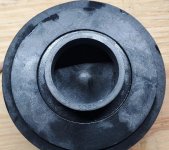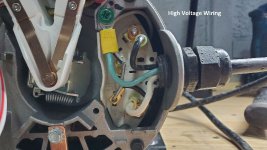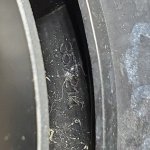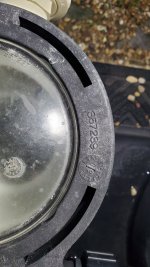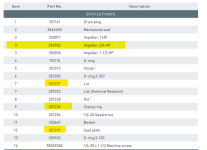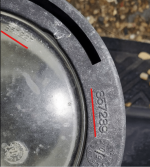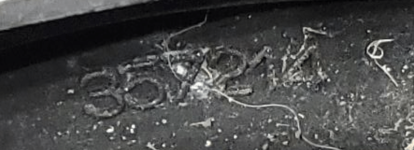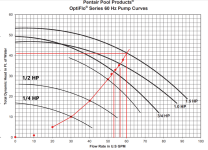The voltage is at or below 120W. I tested this with a multimeter last week. Thank you for your education regarding the impeller HP. I'll pull the motor tomorrow and check the impeller part number to confirm it's 1.5 HP. If so, I'll get my order in for the 3/4 HP impeller ASAP. I'll also rewire the motor to the low voltage configuration. I don't mean to gush, but if not for the expertise of this forum, I'd be fit for a straight-jacket. 
Replace 3-Prong Pool Motor Outlet
- Thread starter lplatz
- Start date
You are using an out of date browser. It may not display this or other websites correctly.
You should upgrade or use an alternative browser.
You should upgrade or use an alternative browser.
Below is an example of the different flow for different impellers.
Reducing the size of the impeller has the same effect as reducing the speed.
Power is proportional to the flow cubed.
Flow is proportional to impeller speed or diameter.
If you get 60 GPM with a 1.5 hp impeller (1,500 watts), you will get about 57 GPM with a 1.0 hp impeller (1,000 watts) and about 53 GPM with a 3/4 impeller (750 watts).
So, reducing the size of the impeller has a very minor effect on the flow but a big effect on the power.
If the impeller was about 0.20 to 0.25 hp (200 to 250 watts), then the flow would be about half.
Note that 1 hp is about 746 watts, but the pump uses about 1,000 watts per hp due to the way pumps are rated.
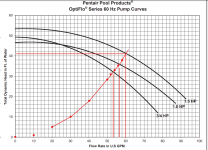
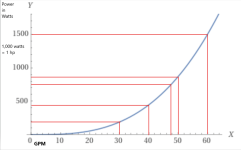
 www.wolframalpha.com
www.wolframalpha.com
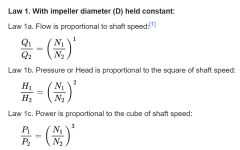
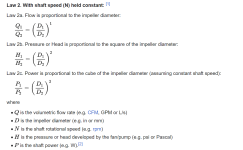
Reducing the size of the impeller has the same effect as reducing the speed.
Power is proportional to the flow cubed.
Flow is proportional to impeller speed or diameter.
If you get 60 GPM with a 1.5 hp impeller (1,500 watts), you will get about 57 GPM with a 1.0 hp impeller (1,000 watts) and about 53 GPM with a 3/4 impeller (750 watts).
So, reducing the size of the impeller has a very minor effect on the flow but a big effect on the power.
If the impeller was about 0.20 to 0.25 hp (200 to 250 watts), then the flow would be about half.
Note that 1 hp is about 746 watts, but the pump uses about 1,000 watts per hp due to the way pumps are rated.


Y = 1500(X/60)^3, y from 0 to 1800 - Wolfram|Alpha
Wolfram|Alpha brings expert-level knowledge and capabilities to the broadest possible range of people—spanning all professions and education levels.


Power is approximately volts x amps.
The amperage shown is the maximum, but the actual should be lower than the maximum.
For the 3/4 hp impeller, the amperage should be between about 6.5 and 9.0 amps depending on the flow.
115 x 9.8 = 1,127 watts. Probably about 750 to 1,000 watts actual.
115 x 12 = 1,380 watts. Probably about 1,000 watts actual.
115 x 16 = 1,840 watts. Probably about 1,500 watts actual.

Note that a pump's rated power is not always the total power.
For example, a 3/4 HP pump with a 1.35 SF (Service Factor) is actually a 1.0 total hp pump.
The amperage shown is the maximum, but the actual should be lower than the maximum.
For the 3/4 hp impeller, the amperage should be between about 6.5 and 9.0 amps depending on the flow.
115 x 9.8 = 1,127 watts. Probably about 750 to 1,000 watts actual.
115 x 12 = 1,380 watts. Probably about 1,000 watts actual.
115 x 16 = 1,840 watts. Probably about 1,500 watts actual.
Note that a pump's rated power is not always the total power.
For example, a 3/4 HP pump with a 1.35 SF (Service Factor) is actually a 1.0 total hp pump.
Last edited:
JamesW - Yep, my brain pretty much reached overload capacity on your shared info. That is a lesson and a half. I greatly appreciate you taking the time to share this information. WOW... who would have thunk. Attached: image of the current impeller. model: 35-3065. Did not see that listed... is this a 1.5 HP impeller? Included also is the before wiring (high voltage) and after wiring (low voltage). I'm ready to order the 3/4 hp impeller as soon as the HP for the 35-3065 impeller is confirmed. Thank you... hope you're having a great day!
Attachments
This reference says that the impeller is the 1 hp impeller.
"Pentair Sta-rite Pump Impeller 350017 1hp Optiflo, Mfg #: 350017, UPC Code: 788379688400, Impeller is marked on face with silver permanent marker with number 17.
Inside vanes on back plate is marked with 35-3064.
The eye is marked with 35-3065.
Impeller thickness outside is 1/2"."
https://mwpools.com/index.php?route=product/product&product_id=5761
"Pentair Sta-rite Pump Impeller 350017 1hp Optiflo, Mfg #: 350017, UPC Code: 788379688400, Impeller is marked on face with silver permanent marker with number 17.
Inside vanes on back plate is marked with 35-3064.
The eye is marked with 35-3065.
Impeller thickness outside is 1/2"."
https://mwpools.com/index.php?route=product/product&product_id=5761
Pentair Sta-rite Pump Impeller 1.5 hp fits Optiflo Pump 1.5 HP, Mfg #: 350018, UPC Code: 788379688417, Impeller is marked on face with silver permanent marker with number 18. Inside vanes on back plate is marked with 35-3064. The eye is marked with 35-3065. Impeller thickness outside is 1/2".
https://mwpools.com/index.php?route=product/product&product_id=5762
https://mwpools.com/index.php?route=product/product&product_id=5762
Verify the impeller with Inyo Pools.
Can you show a picture of the label on the pump with the pump part or model number?
Can you show a picture of the label on the pump with the pump part or model number?
No markings on the pump that I found. The labels are long gone. When we bought the house, this is how I found it. I took a picture of it and sent to INYO. They said it was a Pentair Optiflo pump. But did not provide a model number. The only numbers I could find were on the clamp ring on the filter housing (357239) and Seal Plate (657214). I'll contact INYO to confirm that the Pentair 354522 Impeller will fit this pool pump. Once confirmed, I'll place the order. I'll post my findings.
Attachments
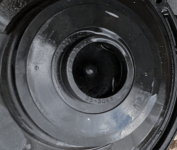
Pentair OptiFlow Pump noise, squealing. Too cold? Looking for advice on repair/replacement
Hello, I'm on year 4 of my first above ground pool experience. This is my first time running into pump issues. Wondering if anyone can give advice on the noises I'm encountering, and if I should start to look into a replacement. I opened early this year prepping for a Raypak NG heater...
JamesW - Based on your last post (8:49P) are you suggesting I go with even a lower HP impeller or were you just playing with the numbers? Do they even make 1/2 & 1/4 HP impellers for the Optiflo pump?
If they made a 1/2 HP impeller, I would use that.
I do not think that they make an impeller smaller than a 3/4 HP, so that is the smallest you can go.
Mostly, I was explaining why lowering the impeller size would not cause as much loss of flow as people might think.
Also, anything over 40 GPM is pretty much too much flow in my opinion.
If you only have 1 skimmer and no heater, I would go with a 1/4 HP impeller if it was available.
I do not think that they make an impeller smaller than a 3/4 HP, so that is the smallest you can go.
Mostly, I was explaining why lowering the impeller size would not cause as much loss of flow as people might think.
Also, anything over 40 GPM is pretty much too much flow in my opinion.
If you only have 1 skimmer and no heater, I would go with a 1/4 HP impeller if it was available.
I like the idea of lowering my energy consumption given the increased runtime during the summer months. All that without any real impact on the performance.  Comm has already been sent to INYO to verify compatibility. Once the motor issue is resolved, I'll be halfway home. Next up, new AquaTrol panel not getting power to the LCD display. More on that later. Would you suggest starting a new thread on that issue? It's related, but different part of the SWG system.
Comm has already been sent to INYO to verify compatibility. Once the motor issue is resolved, I'll be halfway home. Next up, new AquaTrol panel not getting power to the LCD display. More on that later. Would you suggest starting a new thread on that issue? It's related, but different part of the SWG system.
Issue 99.9% assumed resolved. New 3/4 HP Impeller on it's way. Unless another surprise awaits, I feel this issue has been resolved. System is only 1/2 fixed. See the following post
Aqua Trol Control Panel Issues. Earlier in this thread I mentioned issues with my Aqua Trol Control panel. I got tired of the ongoing issues, so I ordered a new one (Hayward W3AQ-TROL-RJ). When I plugged in the new one, I did not get any power to the lights & LCD display. I would have immediately sent it back, but by the time I got around to working on this, the 30 day return window had expired. Given it was new, I didn't feel rushed to test it out on receipt. UGH!!! I found the troubleshooting guide from Hayward (see http://www.haywardnet.com/pdfs/AquaTrol-Troubleshooting-Guide.pdf). The main board passed all the test, except when I got to page 12, step H, I was only getting .02 DC volts between the 2 & 4 pins. I also discovered another Hayward troubleshooting guide (see https://images.inyopools.com/cloud/documents/aquatrol-145-troubleshooting-guide-rev2.pdf). This guide included identical steps with the addition of page 15, Step 4G. This was an AC Voltage test between the orange wire and the green ground lug. I was expecting to get somewhere between 10 to 14 Volts. Ended up getting 21V.
I know JamesW has dealt with this issue before, but I my have wore out my welcome with him. He did a great job working me through my motor issue.
If this post needs to be moved to a new thread or something else, please let me know.
I know JamesW has dealt with this issue before, but I my have wore out my welcome with him. He did a great job working me through my motor issue.
If this post needs to be moved to a new thread or something else, please let me know.
The following are the series of tests conducted on the main board.
- main board check, minus the dsp pins check
- orange lead to green ground lug check
- dsp pins check
For the pin test, one probe goes to pin 2 and the other probe goes to pin 4.
You are measuring voltage between the pins.
You are measuring voltage between the pins.
Thread Status
Hello , This thread has been inactive for over 60 days. New postings here are unlikely to be seen or responded to by other members. For better visibility, consider Starting A New Thread.


